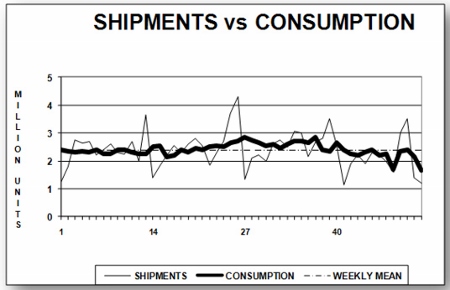Aphorism 6: The Surest Way to Get a Better Forecast is to Make the Demand Forecastable
Forecast accuracy is largely dependent on volatility of demand, and demand variation is affected by our own organizational policies and practices. So an underused yet highly effective solution to the forecasting problem can be to just make the demand more forecastable!
Most (if not all) companies have some power to shape customer demand by adjusting pricing, promotions, supply, and distribution practices. Rather than passively accepting demand patterns as given, a more proactive approach would be to shape the demand into more favorable (i.e., less volatile, more predictable, and less costly to fulfill) patterns.
It is helpful to distinguish inherent volatility (the natural variation in the consumption of your products by consumers) from artificial volatility (the additional variation in sales or shipments due to organizational policies and practices).
It is not unusual to find the consumption of a consumer product (as indicated by the point-of-sale data at retail) to be fairly stable and predictable, yet shipments of the product (from manufacturer to retail store) to be highly erratic.
 In this chart, weekly consumer purchases at retail are shown by the thick line, which shows very little inherent volatility and could be forecast quite accurately with a simple model. However, the thin line shows shipments from the manufacturer to the retailer, and is three times more volatile.
In this chart, weekly consumer purchases at retail are shown by the thick line, which shows very little inherent volatility and could be forecast quite accurately with a simple model. However, the thin line shows shipments from the manufacturer to the retailer, and is three times more volatile.
The highly erratic and hockey stick patterns are indicative of artificial volatility – excess variation which is caused by sales, marketing, and financial practices, like creating incentives to spike demand to hit quarterly sales targets.
- Corollary: Any knucklehead can forecast a straight line.
By identifying and eliminating those practices that encourage volatility, you will be able to smooth sales patterns. As a result: Reduced inventory and capacity requirements, better customer service, lower costs, and better forecasting are immediate outcomes.
For the final aphorism, I want to credit a wise man Cecil Moore, who I worked for in my last industry job as Director of Forecasting at Sara Lee Intimate Apparel. Cecil's guidance to us, was to:
Aphorism 7: Just Stop Doing the Stupid $#!+
This is the essence of the Defensive paradigm. Rather than make heroic efforts trying to eke out a fraction of a percent of accuracy through more elaborate and costly modeling and Offensive approaches -- simply stop doing the things that are just making the forecast worse.
With tools like FVA analysis, and the additional guidance and direction provided by the Morlidge articles in Foresight, it is quite possible to achieve more accurate forecasts with less effort and less cost.
What responsible business manager or executive could complain about something like that?
[See all 12 posts in the business forecasting paradigms series.]
